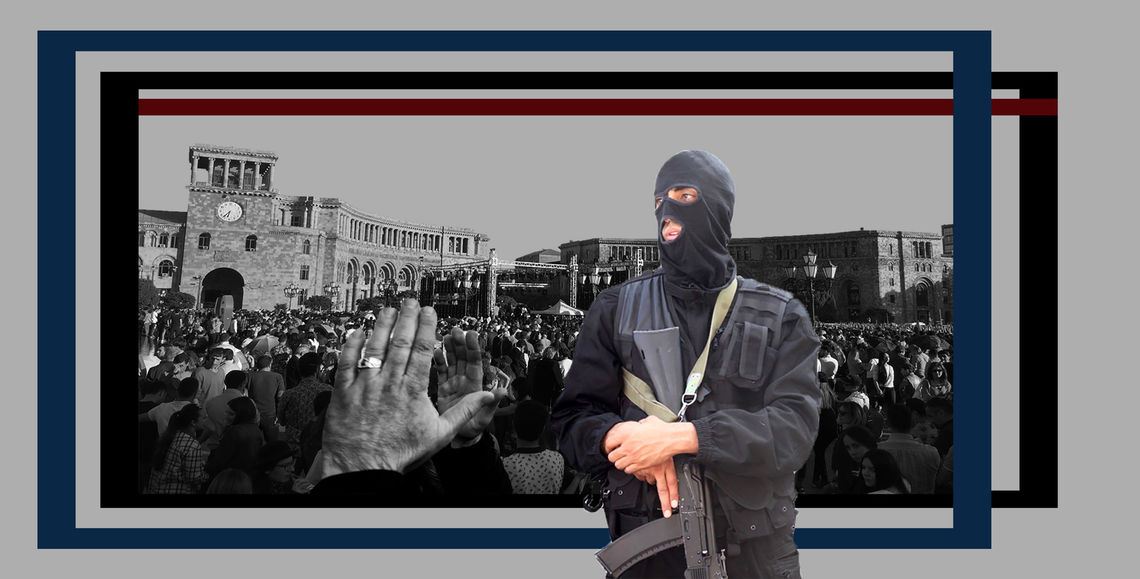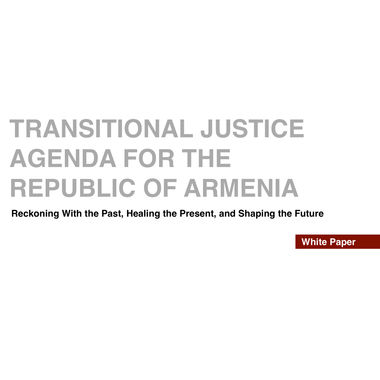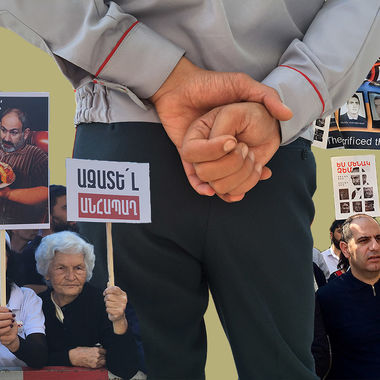
One of the most fascinating developments in post-Velvet Revolution Armenia has been the meteoric rise in popularity of the National Security Service (NSS), the dominant state agency within the state's security apparatus. The NSS' mandate is a fusion of domestic security responsibilities as well as counter-intelligence and espionage. But for the better part of the last 30 years, NSS has not really been preoccupied with either proper policing work or espionage; rather, the NSS has primarily served as the enforcement arm of Armenia's previous regimes. In this context, the NSS' legacy is defined by extra-legal and illegal activities in service of the economic and political elite. Simply put, the NSS was instrumental is sustaining and reproducing the hierarchy of corruption. For this reason, the NSS had become synonymous with corruption, abuse of power, systemic suppression, and quite simply, instilling fear within the public. It was a well-known fact among citizens that if the NSS came after you, regardless of your rights and liberties as a citizen, you were in extraordinary trouble. It is no wonder that the fear the Soviet citizen had of the KGB became a sort of inheritance; only now under the auspices of the NSS.
Supplementing the public's fear of the NSS was the inherent distrust that Armenian society had towards this institution. Perceived as the praetorian guard of the ruling elite, the NSS suppressed political dissidents, fabricated investigations and evidence, and exercised extensive institutional power over both Armenian society as well as all branches of the Armenian government. Collectively, citizens did not trust the NSS to uphold the law, and by extension, the NSS guaranteed the status of those that operated above the law.
The question, then, re-poses itself: how did the most feared and distrusted state agency become one of the most celebrated institutions in post-Velvet Revolution Armenia? Before answering this question, however, let us consider the data demonstrating the NSS' standing with the Armenian public. After the Velvet Revolution, the International Republican Institute (IRI) conducted three public opinion polls in Armenia, with survey data specifically illustrating positive trends in public trust towards the NSS.
The public ranked the NSS as the fourth most popular state institution, with the Prime Minister’s Office, the Army, and the President's Office ranked ahead.
In the first survey, conducted in August of 2018, 48 percent of respondents had a positive perception of the work undertaken by the NSS. As such, within a three month time frame after the removal of the Sargsyan Administration, almost half of Armenian society had already developed a positive perception of the once-feared agency. Two months later, in October of 2018, a second IRI survey demonstrated the continuous and incremental increase in the NSS' popularity. The public ranked the NSS as the fourth most popular state institution, with the Prime Minister’s Office, the Army, and the President's Office ranked ahead. Considering that the Prime Minister's Office and the President's Office are not, properly speaking, viewed as institutions by the Armenian public, but rather, as personalized structures (Nikol Pashinyan is synonymous with the Office of the Prime Minister; Armen Sarkissian is synonymous with the Office of the President: the Armenian public does not make the demarcation between the individual and the office), the NSS ranked second behind Armenia's most revered institution, the Army. In a two month period, the popularity of the NSS had jumped from 48 percent in the first poll to 78 percent in the second poll. A 30 percent increase in popularity, within a two month period, is not only extraordinary, but also indicative of a shift in Armenia's political culture: the security apparatus was no longer feared or distrusted. Approximately seven months after the second survey, a third IRI survey was conducted in May of 2019, which demonstrated the stabilization of the NSS' favorability rating among the public. The important indicator here is the fact that the NSS’ meteoric rise in popularity was neither a fluke, nor a temporary result of public euphoria. Collectively, the NSS has maintained its popularity among the Armenian public within the high-70 percentile; an extraordinary achievement for an institution that was, only a year ago, despised and feared by Armenian society.
Understanding the Popularity of the NSS
Several important factors explain the NSS phenomenon, of which the most important and obvious indicator is the fight against corruption. As such, three different factors explain the rising popularity of the NSS: 1) Policy (implementation of anti-corruption program and increased transparency); 2) Personalization (the rapid rise of Artur Vanetsyan, Head of the NSS); and 3) Public Relations (successful media campaign enhancing image of NSS).
While the formation of the anti-corruption drive has been spearheaded by the Office of the Prime Minister, the implementation of this policy falls within the purview of the NSS. In the eyes of the Armenian public, the popularity of Prime Minister Nikol Pashinyan spilled over and enhanced the popularity of the NSS: the former develops policy, while the latter enforces it. In the most recent IRI survey of May 2019, when ranking the biggest success of the government, respondents ranked “decreased corruption” as the number one choice (this was also considered the number one achievement of the government in the previous surveys). Further, 58 percent of respondents noted that the fight against corruption is getting better, while only 11 percent noted that it is getting worse. The improved perception in the fight against corruption is credited to the following top three developments: 1) “NSS disclosures” (transparency and anti-corruption activities); 2) “Detention of oligarch leaders”; and 3) “Disclosure of bribery cases.” With respect to “NSS disclosures,” survey results demonstrate that 71 percent agree that the NSS is “open and transparent,” an impressive vote of confidence for an agency that has been historically reviled.
In Armenia’s political culture, personalization is the primary mechanism of perceiving political developments: the head of an institution becomes synonymous with that institution. Within this context, the popularity of the NSS cannot be separated from the popularity of Artur Vanetsyan.
The second factor explaining the increased popularity of the NSS has been the personalization of the NSS by its former head, Artur Vanetsyan. As noted earlier, in Armenia’s political culture, personalization is the primary mechanism of perceiving political developments: the head of an institution becomes synonymous with that institution. Within this context, the popularity of the NSS cannot be separated from the popularity of Artur Vanetsyan; we cannot disaggregate where one ends and the other begins. To this end, as the NSS became celebrated for its anti-corruption efforts, Vanetsyan became the government’s poster boy. This, in essence, was a unique phenomenon: the concept of an honest cop is a rare commodity in the political psychology of Armenian society. As the second IRI survey demonstrates, Artur Vanetsyan became the third most popular figure in Armenia, behind only PM Nikol Pashinyan and President Armen Sarkissian. The fact that the Head of the NSS can have a popularity rating of 77 percent in Armenia is a tectonic shift in its political culture. In this light, Vanetsyan’s immense popularity became intertwined with the institution itself: the NSS belonged to Vanetsyan, and by extension, Vanetsyan was the poster boy for Armenia’s success in decimating corruption.
The third factor was the NSS’ immensely successful public relations campaign, which has been a fusion of slick propaganda videos, staged disclosures of high-profile arrests, and extensive access by the press to Vanetsyan. Contextually, whereas the activities of the NSS prior to Vanetsyan’s leadership were heavily secretive, access to NSS personnel by the media extremely rare, and strategic media campaigns nonexistent, all of this changed after the Velvet Revolution. The secretive Head of the NSS was now somewhat of a media celebrity, commenting not only on high-profile arrests, but also on political developments: Vanetsyan became a center of attention for Armenian society. Just as importantly, by utilizing a more informative website, press releases, short propaganda films, and the constant presence of Vanetsyan as the public face of the NSS, the agency was able to control the narrative when it came to the fight against corruption. More specifically, as public trust in the NSS skyrocketed, the ability to control this narrative became even more influential. This influence, of course, was not simply institutional, it was also personal: Vanetsyan had become the second most influential, and by extension, the second most powerful figure in the country.
The Illusion of Vanetsyan: The Personalization of the NSS, Investigative Stagnation and Selective Justice
The personalization of institutions in Armenia remains a prevalent problem, but this is not simply a systemic problem, it is also a cultural problem. The fundamental problem with personalization is that it limits and hampers institutionalization; citizens, for example, do not speak of the Office of the Prime Minister or the National Security Services, rather, they speak of Pashinyan and Vanetsyan. The person becomes the institution. The problem with this, of course, is that it also personalizes politics; issues are not viewed as institutionally complex or intricate, rather, they are viewed as personal conflicts between individuals. A further concern with personalization is that the powers of the institution now become the personal power base of the individual: the institution becomes the leader’s own fiefdom. In post-Velvet Revolution Armenia, however, this latter situation has not yet materialized, and in this context, personalization has not transitioned into the personalization of institutional powers. But the danger is there, especially when the given individual enjoys immense public popularity.
A simple question, that perhaps many people are thinking but do not want to ask, presents itself: How can an institution that for decades excelled at committing injustice, overnight, become an institution that embraces law, order, transparency, and democratic values?
On September 16, in a development that sent shockwaves through Armenia’s political circles, Artur Vanetsyan resigned from his position as Head of the NSS. This “resignation,”of course, was more of a dismissal: the Pashinyan Government no longer needed the services of Vanetsyan. Two issues become prevalent that need to be addressed: 1) what are the implications of this on the popularity of the NSS?; and 2) does Vanetsyan’s dismissal indicate that the NSS was not as “open and transparent” as the public thought; namely, was the public’s trust in the NSS misplaced? The problem at hand, again, becomes obvious: the lack of separation between the institution and the individual automatically politicizes the institution. This, in itself, brings up a wide array of questions that the NSS now needs to answer; more specifically, did the personalization of the NSS under Vanetsyan give way to investigative stagnation and the selective distribution of justice?
A simple question, that perhaps many people are thinking but do not want to ask, presents itself: How can an institution that for decades excelled at committing injustice, overnight, become an institution that embraces law, order, transparency, and democratic values? We have never honestly posed this question. The same NSS officers that were, for example, taking bribes, extorting, or abusing arrestees are the same agents that are now “professionalized” into spearheading the anti-corruption campaign. The NSS has not undertaken any expansive reforms, changed personnel, or overhauled the institution: the same individuals that were doing the bad deeds are supposedly now doing good deeds. At least this is what Vanetsyan has been arguing for quite some time. Be that as it may, there are, nonetheless, a broad set of questions that Vanetsyan must answer with respect to investigative stagnation and selective justice.
Under Vanetsyan’s tenure an extensive number of investigations were initiated dealing with corruption and abuse of power by members of the previous regime, ranging from public officials to powerful businessmen. The question that arises is quite simple: What has been the end result of these high-profile arrests and investigations? Was the anti-corruption program, as implemented under Vanetsyan’s stewardship, a mirage, or has there been substantive results? This is the illusion of Vanetsyan. A more pertinent question also presents itself: Why have certain oligarchs or public officials been targeted, while others have not? Between concerns of investigative stagnation and selective justice, the popularity and illusion of Vanetsyan can only go so far. While there are a wide-range of case studies—from Ruben Hayrapetyan (“Nemetz Rubo”) to Aghvan Hovsepian’s “Aparan clan” to Khachatur Sukiasian (“Grzo”) to numerous other individuals—that may be presented addressing concerns of investigative stagnation and selective justice, for the sake of parsimony, four will be assessed.
One of the most notorious members of the previous regime, a former member of parliament that illegally and through extortion dominated the Yerevan district of Erebuni, one who blurred the line between businessman, politician, and gangster, and one who happens to have the moniker “Toghmaghi Mher” has, astonishingly, not been touched by the NSS during Vanetsyan’s tenure. The person of reference here is, of course, Mher Sedrakyan, whose prolific vulgarity towards journalists was perhaps his better side, a consummate “heghinakutyun” who controlled both criminals and the police in his fiefdom of Erebuni. That the NSS has not targeted Sedrakyan’s past crimes, his network of acolytes, and his economic empire attained through illegal enrichment remains a mystery. This mystery, of course, must be unraveled by the NSS, but the fact that such a mystery exists creates concerns of trust and selective justice. Why has someone like Sedrakyan not been touched, while others, who have come nowhere close to the things that he has done, been subjected (rightly so) to justice? That Vanetsyan is very close friends with Sedrakyan’s son, for example, may perhaps create more questions than answers. While we are not here to speculate, we can, however, express our concern at the unequal distribution of justice.
A similarly fascinating case of investigative stagnation, and one that has been speculated upon extensively, has been the case of Mikayel Minasyan, son-in-law of former President Serzh Sargsyan, as well as Sargsyan’s former chief-of-staff and Armenia’s ambassador to the Holy See at the Vatican. Minasyan’s immense wealth, his dominance of Armenia’s media, and his expansive abuse of his authority to illegally enrich himself is not only an open secret, but rather, has been verified by various Armenian investigative journalists. This, again, poses the question: Why has someone like Minasyan not been touched, while others, who have come nowhere close to the activities that he has undertaken, been subjected (rightly so) to justice? Again, we refrain from speculating, but there are undeniable patterns that indicate lack of investigative rigor and enforcement of the law by Vanetsyan’s NSS. The fact that charges were brought against Minasyan, immediately upon Vanetsyan’s dismissal, is an astonishing coincidence. But again, one should not speculate…
If the corruption of Sedrakyan was not very sophisticated, or if the corruption of Minasyan was overly-sophisticated, the astounding corruption of former Prime Minister Hovik Abrahamyan was simply blatant. He is considered one of the more prolific organizers of corruption from the previous regime. Possessing the moniker “Mook” (Mouse), he is a peasant-turned-lord of Ararat, who not only monopolized most of the industry and agriculture of the region, but expanded his wealth by embezzling the country’s institutions. The NSS’ comical investigation of Abrahamyan has also astonished most observers: a simple investigation of illegal gun ownership that Abrahamyan’s brother assumed responsibility for. Years of illegal enrichment, abuse of power, and transparent embezzlement did not seem sufficient for Vanetsyan to direct the NSS into properly investigating and bringing charges.
One of the more powerful individuals in the city of Yerevan, assuming the moniker of “Chorny” (meaning “black” in Russian), Gagik Beglarian professionalized the art of corruption and embezzlement in his capacity as both Mayor of Yerevan and then Minister of Transportation. Beglarian’s abuse of authority as Mayor of Yerevan was so profound that he was actually forced to resign by Serzh Sargsyan (regardless of the fact that two were allies). Exercising extensive control over the city’s construction and jewelry industries, Beglarian utilized his position as Mayor to both plunder and amass a huge economic empire through sophisticated kickbacks. Furthermore, when later appointed Minister of Transportation, he played an important role in orchestrating the embezzlement of funds from the North-South Highway construction project, one of the more extravagant embezzlement cases in recent memory. Taxi driver-turned-oligarch, Beglarian is the perfect archetype of the criminal-politicians that made up the ruling elite of the previous regime: contemptible individuals who preyed on their own society. Trying to cogently comprehend why Vanetsyan’s NSS did not pursue a criminal of this magnitude defies all understandings of equal application of the law.
Conclusion
Can the popularity of the NSS be sustained after Vanetsyan’s dismissal and the broad set of questions and concerns that have been addressed above? Armenian society has been quite patient with the NSS’ selective application of justice; but this patience is conditioned upon the assumption that a broader process is at work and that equal justice will soon be applied to all who had propped up the corruption and repressiveness of Armenia’s previous regimes. Simply put, considering that Armenian society has placed its trust in the NSS, this trust has been qualified by a hope that all, and not simply a few, perpetrators will be held accountable. Whether Vanetsyan has or has not violated this trust cannot be speculated upon at this point. However, considering that 16 months have passed since the Velvet Revolution, and many of these formerly-powerful figures have not been touched by the scales of justice, a great deal of concern has arisen. Whether or not this is largely Vanetsyan’s fault also cannot be substantively answered at this point.
So, can the popularity of the NSS be sustained? Indeed, the popularity of the NSS can be sustained, but only through one mechanism: rigid institutionalization and the complete alleviation of the personalization of politics in Armenia. The head of an institution cannot and should not become bigger or more celebrated than the institution itself. That Vanetsyan became bigger and more celebrated than the institution he ran is quite evident. That Armenia’s political system and political culture is just as much at fault for such a development is also quite evident. And finally, what has also become quite evident is the illusion: that Vanetsyan was a great anti-corruption crusader.
EVN Report welcomes comments that contribute to a healthy discussion and spur an informed debate. All comments on Readers' Forum will be moderated, thereby any post that includes hate speech, profanity or personal attacks will not be published, including abusive, threatening, racist, sexist, offensive, misleading or libelous language. Comments deemed to be spam or solely promotional in nature will not be published. Including a link to relevant content is permitted, but comments should be relevant to the post topic.
white paper on trasitional justice
Transitional Justice Agenda for the Republic of Armenia
By Nerses Kopalyan
Should Armenia implement the tools of transitional justice? This White Paper, developed by Dr. Nerses Kopalyan is a comprehensive transitional justice agenda for the Republic of Armenia.
also read
On the Elaboration of Armenia’s New National Security Strategy
By Sossi Tatikyan
Armenia is set to have a new National Security Strategy. The current strategy, adopted in January 2007, had all the necessary components, but was outdated and remained a largely superficial and declarative document as many of the defined values and principles were not fully respected or promoted.
On the Use of the Army in Suppressing Protests in Armenia in March 2008
By Sossi Tatikyan
While Armenia’s second President Robert Kocharyan’s trial continues, Sossi Tatikyan writes about the need to amend relevant provisions of the Constitution to delineate the distinct responsibilities of the army and internal security forces, and to ensure checks and balances when declaring a state of emergency.





